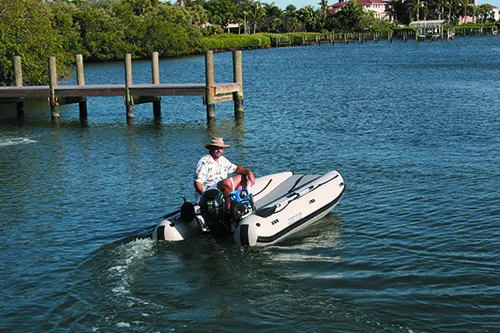
Our search for a compact inflatable dinghy led us to the Takacat LX, a line of inflatable catamarans developed in New Zealand. Established in 2007, Takacat (www.takacat.com) has grown a steady following abroad and distribution in North America is expanding. Hulls are built in China, but the company is looking into U.S. production.
We spent two afternoons with Luis Sanchez, of Sky Blue Adventures (www.skyblueadventures.com) testing the Takacat 340 ($2,000, 11’ LOA, 5’5” beam, 19” tube diameter, 1,135 lb. capacity). The 340 is the middle boat in the five-boat series, ranging from 8 to 14 feet. The two larger sizes, the 380 and 420, divide each hull into two air chambers, but otherwise the construction details are consistent throughout the XL line. Thermo-welded PVC hulls are available in several colors. Glued hypalon hulls are an option.
We tested the boat with two motors—a 9.9 horsepower LEHR propane outboard (about 15 lbs. lighter than a conventional gas 9.9 hp), and the electric ePropulsion Spirit 1.0, (1,276 watt-hours, 3 hp equivalent). Made in China, the $1,700 ePropulsion competes with the well-established Torqeedo (see “New Options in Small Outboards,” PS January 2016).
The boat’s compactness deflated is impressive. The 79-pound boat splits into two bags: hulls (48 pounds, 47” x 14” x 14”); and transom/floor (31 pounds, 35.5” x 14” x 10”). Assembly takes about 10 minutes with a good pump that inflates to at least 10 psi (the rated floor pressure). The hull and deck sections connect with multiple webbing straps and an ingenious “open” transom that also helps spread davit loads.
The conspicuous open bow and stern of the Takacat design allows for flatter, more expansive, and more stable platform than any comparable inflatable we’ve tested. Boarding from water or shore is easier, but what about water ingress? Crossing big boat wakes on the ICW, we shipped no waves. The maker points to its long use its popularity among rescue organizations in New Zealand as proof of its seakeeping ability.
Under the ePropulsion motor, we hummed quietly along at 5 mph with two people (~ 400 pounds). Prop cavitation interrupted the Lehr test, but we were later able to get it to cruise on plane at about 12 knots. According to Sanchez, an anti-cavitation plate (sold separately) solves the problem.
Bottom line: The Takacat fits a unique niche in the dinghy market. Snorkelers, sight fisherman (especially fly fishermen), and cruisers with limited storage space would all benefit from including the Takacat XL line in their list of options.





































